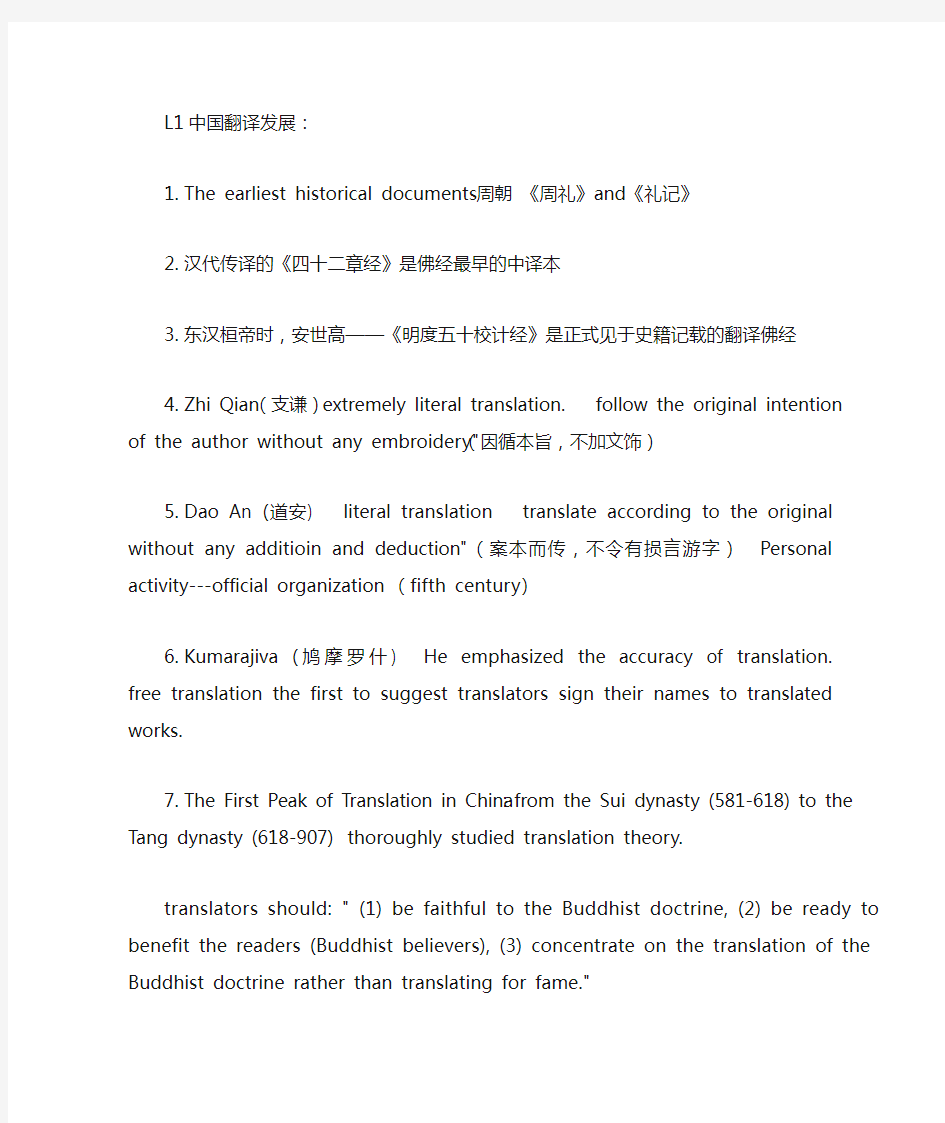
翻译概论 知识点整理
- 格式:docx
- 大小:33.72 KB
- 文档页数:7


L1中国翻译发展:
1.The earliest historical documents 周朝《周礼》and《礼记》
2.汉代传译的《四十二章经》是佛经最早的中译本
3.东汉桓帝时,安世高——《明度五十校计经》是正式见于史籍记载的翻译佛经
4.Zhi Qian(支谦)extremely literal translation. follow the original intention of the author
without any embroidery"(因循本旨,不加文饰)
5.Dao An (道安) literal translation translate according to the original without any
additioin and deduction"(案本而传,不令有损言游字)Personal activity---official organization (fifth century)
6.Kumarajiva (鸠摩罗什) He emphasized the accuracy of translation. free translation
the first to suggest translators sign their names to translated works.
7.The First Peak of Translation in China:from the Sui dynasty (581-618) to the Tang dynasty
(618-907) thoroughly studied translation theory.
translators should: " (1) be faithful to the Buddhist doctrine, (2) be ready to benefit the readers (Buddhist believers), (3) concentrate on the translation of the Buddhist doctrine rather than translating for fame."
8.玄奘:将佛经由梵文译成汉文,而且把老子著作的一部份译成梵文,成为第一个把汉文
著作向国外介紹的中国人Contribution to theory: set down the famous translation criteria that translation "must be both truthful and intelligible to the populace."(既須求真,又須喻俗,意即忠实、通順) Aiming to achieve an intelligibility of the translation for the target language readers
9.P3. 明清之际的科技翻译
Western Christian missionaries(利玛窦...)Assisted by Chinese collaborators (徐光启、李之藻)
利玛窦、徐光启:《几何原本》、《测量法义》,利玛窦、李之藻《同文算指》,利玛窦:论语、孟子、大学、中庸——拉丁文
第二次翻译高潮
(1) The subject of translation shifted from Buddhist scriptures to scientific and technological
knowledge;
(2) translators in this period of time were mainly scientists and government officials who
were erudite scholars, and the western missionaries who brought western knowledge to China.
10.the 3rd peak:from the mid 19th century to May 4th Movement
emphasis on Western works of social soiences, military sciences and literature
11.林则徐(1785-1850):Geography (Gazette of the Four Continents《四洲志》);
李善兰(1811-1882):Geometry《几何原本》;
严复:《天演论》、《原富》;
林纾:《茶花女》,《块肉余生述》,《黑奴吁天录》《鲁滨逊漂流记》
12.Translation in Modern period(1919-1949):focus on the translation of Karl Marx's
(1818-1883) and Lenin's (1870-19224) works on socialist and communist theories(社会主义和共产主义), and the translation and re-translation of western literature.
朱生豪:莎士比亚戏剧全集
张谷若:德伯家的苔丝》和《还乡》,哈代的《无名的裘德》、狄更斯的《大卫·考坡菲》P7,鲁迅,矛盾,郭沫若,付东华,傅雷,林语堂
13.杨必:玛丽亚•埃杰窝斯的《剥削世家》,翻译萨克雷(W. M. Thackeray)的Vanity Fair
(《名利场》
杨宪益和戴乃迭:《红楼梦》《老残游记》《离骚》《儒林外史》《鲁迅选集》《奥德修纪》《卖花女》
许渊冲:翻译了《诗经》、《楚辞》、《李白诗选》、《西厢记》、《红与黑》、《包法利夫人》、《追忆似水年华》等众多名著。
葛浩文:萧红《呼兰河传》《生死场》莫言《红高粱》《丰乳肥臀》《生死疲劳》
西方翻译发展:
1.The 1st phase: 3rd Century BC.:the introduction of Greek classics to Roman
Odyssey《奥德赛》(in Latin, 安德罗尼柯,西方翻译史上最早的译作) P10-17
L4 UNIT6:翻译的标准
1.严复
“信、达、雅”faithfulness expressiveness elegance
“信”(faithfulness)——达旨(将原文说明),“达”(expressiveness)——前后引衬,以显其意,“雅”(elegance)——尔雅(用汉以前字法句法)P84
2.鲁迅:“忠实,通顺”(faithfulness and smoothness)
一是易解,二是保存原作的丰姿"凡是翻译,必须兼顾两面,一当然力求其易解,一则保存着原作的丰姿。"
The Debate:
梁实秋、赵景深“宁错务顺”鲁迅“宁信不顺”瞿秋白“信顺统一”
以鲁迅为首的一批左翼学者主张直译,而以梁实秋为首的一批右翼学者则主张意译。直译派认为意译让“洋人穿了长袍马褂”,消解了原文的异国情调;意译派认为直译以辞害义。值得注意的是,鲁迅在当时就已经明确地提出归化与异化的问题
3.林语堂:忠实、通顺、美译者不但要求达义,并且要以传神为目的,译文必须忠实于原文之字神句气与言外之意。
傅雷:神似(resemblance in spirit) 以效果而论,翻译应像临画一样,所求的不在形似,而是神似。
4.泰特勒三原则Tytler’s Three Principles (1790)
(1)译文应完全传达原文的思想。(A translation should give a complete transcript of the ideas of the original work.)
(2)译文的风格和笔调应与原文一致。(The style and manner of writing should be of the same character as that of the original.)
(3)译文应像原文一样流畅。(A translation should have all the ease of the original composition.)5.等值翻译(equivalent translation)P87
泰特勒(1790)“等值原则”:“好的翻译是把原作的长处完全移注到另一种语言里,使得译入语国家的人们能清晰的领悟和强烈的感受,其程度和使用原作语言的人相等。”
费道罗夫(1953)“翻译等值伦”:作用相符,语言与文体相符
卡特福德(1965):replacement,equivalent textual material 翻译实践的中心任务是在译语中寻找“对等物”译文与原文在语言内容与形式上的最大近似度等值的相对性、动态性
6.奈达区分了两种不同的翻译:形式对应(formal correspondence)和动态对等(dynamic equivalence)。形式对应注重译文信息本身的形式和内容尽可能贴近原文,动态对等则是以译文对读者的效果为标准。奈达因此将翻译的焦点从文本转移到译文读者身上,主张只有译文读者对译文做出的反应和原文读者对原文的反应基本相同,才是成功的翻译,他的“对等